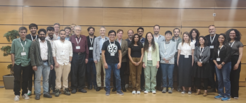ERC Synergy Project UnMySt Launches with International Kick-Off Meeting in Strasbourg
The ERC Synergy project Unravelling the Mysteries of Vibrational Strong Coupling (UnMySt) officially began with a two-day kick-off meeting hosted at the Institut de Science et d’Ingénierie Supramoléculaires (ISIS) in Strasbourg. Bringing together all participating research groups from Tel Aviv University, Université de Strasbourg, the University of Pennsylvania and the Max Planck Institute for the Structure and Dynamics of Matter, the meeting marked the beginning of a six-year collaboration at the forefront of chemistry, quantum electrodynamics, and materials science.

UnMySt explores how tailored electromagnetic environments can control chemical and physical behavior in molecules—a frontier area known as polaritonic chemistry, which merges concepts from chemistry and cavity quantum electrodynamics. In particular, the project focuses on Vibrational Strong Coupling (VSC), a phenomenon in which molecular vibrations are hybridized with electromagnetic cavity modes. This interaction can modify chemical reaction rates, yields, and other molecular properties—even in the absence of light. While VSC holds great promise for the control and design of chemical systems, the mechanisms behind these effects remain largely unresolved. By integrating advanced experimental and theoretical approaches, UnMySt aims to establish a robust framework for cavity-controlled chemistry. The consortium will address key open questions about how VSC influences chemical reactivity, material properties at equilibrium, non-equilibrium dynamics such as charge transfer, and the role of symmetry in determining reactivity under strong light–matter coupling.

The kick-off meeting provided an essential opportunity for researchers—from senior PIs to postdocs and PhD students—to align scientific goals, define collaborative strategies, and establish strong personal and interdisciplinary connections. We look forward to seeing the synergy among the participating groups deepen in the years ahead—and to the groundbreaking insights their joint work will bring to the field.













